Education in Newry and Mourne: an Historical Perspective
29th September 2016 – 3rd September 2017
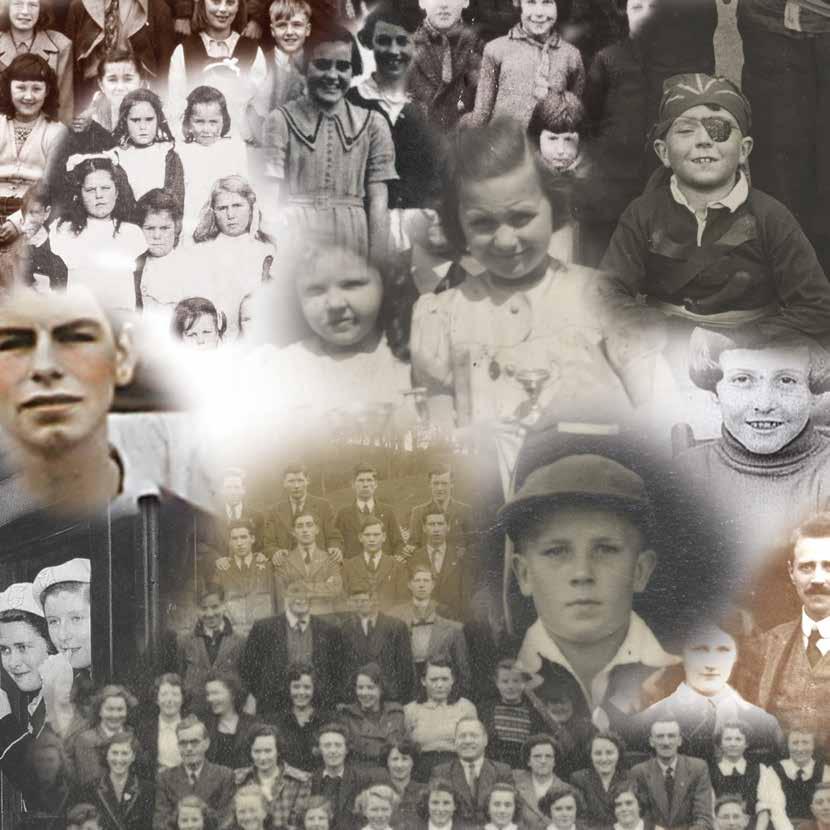
Beulah Private School, Kilkeel c.1928 – 1930. This school was a kindergarten and preparatory school run by Mrs Gordon (back row, far right), which taught children from the age of 3 up to 12 years of age
Courtesy of Catherine Hudson

Réamhrá an Chathaoirligh
Is cúis mhór athais domh réamhrá a scríobh don leabhrán seo a ghabhann leis an taispeántas sealadach de chuid Iarsmalann an Iúir agus Mhúrn, “Oideachas san Iúr agus Múrna: Dearcadh Stairiúil”.
Ag baint leas as cáipéisí, grianghrafanna agus ábhair, cíorann an taispeántas seo soláthar oideachais sa cheantar. Scrúdaíonn sé ról na scoileanna príobháideacha sa 19ú haois, tús agus éifeacht na scoileanna náisiúnta, tionchar na n-aicmí creideamh in oideachais na háite and athruithe a tugadh isteach faoin reachtaíocht.
Pléitear forbairtí i modhanna teagaisc agus ábhar na gceachtanna thar na blianta. Tugann réimse leathan deantán roinnt athchuimhní do na seandaoine chomh maith le léargas ar shaol na scoile sna laethanta fadó do pháistí agus do dhaoine óga. Tugann an taispeántas seo léargas dúinn ar ghné staire áitiúla agus oidhreachta agus díríonn sé aird ar ról ríthábhachtach an oideachais i bhforbairt an tsochaí i gceantar an Iúir agus Mhúrn. Thar ceann na hIarsmalainne ba mhaith liom mo bhuíochas a ghabháil le achan uile duine a ghéill d’iarratas na hIarsmalainne i dtaca le deantáin, doiciméid agus eolas. Is mór againn a gcuid flaithiúlachta.
An Comhairleoir Gillian Mhic Giolla Phádraig Cathaoirleach Chomhairle Ceantair an Iúir, Mhúrn agus an Dúin
Chairperson’s Foreword
I am delighted to write the foreword to this booklet which accompanies “Education in Newry and Mourne: an Historical Perspective”, a temporary exhibition at Newry and Mourne Museum.
Drawing on documents, photographs and objects, this exhibition explores the provision of education in the area. It examines the role of private schools in the 19th century, the introduction and impact of National Schools, the influence of religious denominations in local education and changes introduced by legislation.
Developments in teaching methods and the content of lessons over the decades are also considered. The range of artefacts on display provide this exhibition with a strong reminiscence element for older people while giving children and young people an insight into school life in by-gone days.
The exhibition will help us gain an insight into this aspect of local history and heritage and highlight the vital role education has made in the development of society in the Newry and Mourne area.
On behalf of the Museum, I would like to thank all those who responded to the Museum’s appeal for artefacts, documents and information. Their generosity is much appreciated.
Councillor Gillian Fitzpatrick Chair of Newry, Mourne and Down District Council
Introduction
Prior to the 1830s most education provision was private, either funded through churches, landowners or charitable organisations.
In south Armagh, for example, a schoolhouse was built in Ballymoyer by the Kildare Place Society in the early 19th century. This was subsequently endowed by Marcus Synnot, the local landlord. Hedge schools, mainly for the education of rural Catholic children, were also found throughout the district.

During the course of the 19th century there was an increasing awareness of the lack of intermediate (secondary) education in Ireland. Secondary education was provided by Protestant endowed schools and by Catholic religious orders including the Christian Brothers, who came to Newry in 1851, and Loreto Sisters.
Originally located in a private house, Newry Bunscoil (primary school) moved to the former gasworks, Kilmorey Street, Newry in 1990, and a new Bunscoil building opened on site in December 1997. Pictured at the opening, left to right, are Bríd Ní Rabhartaigh, Maria Caraher, Rev. Mervyn Kingston, Nóra Palmer and Siobhán Jackson

Courtesy of Stiofán Loughran Collection, Gaeláras Mhic Ardghail
The Agricultural and Technical Instruction Act (1899) provided for training in technical skills to support the economy, and technical schools were opened locally in Newry, Kilkeel and Warrenpoint.
funding, could go to a fee paying grammar school.
In Newry, in 1948, the Intermediate School became Newry Grammar School. The post war years also saw changes in secondary school qualifications, with the introduction of national qualifications.
The provision of education in Northern Ireland remains a contentious issue. Although integrated education is expanding, it is still a highly segregated education system at primary and secondary school level. Debate still continues with regard to academic selection at the age of eleven.
A new education system was introduced in Ireland with the Education Act (1831) which established the Board of National Education. This provided nondenominational education and National Schools began to be built throughout Ireland. This included the monitorial method of teaching which was first put into practice in 1845. This gave talented pupils the opportunity to become monitors and go on to teacher training college.
A nationwide campaign for the introduction of intermediate education resulted in the passing of the Intermediate Education (Ireland) Bill (1878). This established a Board which oversaw the setting of courses, use of textbooks and the standard of examinations. Intermediate schools began to be built in various towns throughout Ireland and one was established in Corry Square in Newry.
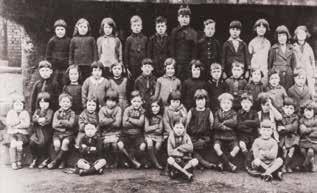
In 1892 education became compulsory for all children between 6 and 14. The Belmore Commission was set up in 1897 and concluded that the curriculum was out of date and too narrow. A number of recommendations were made to include practical skills such as drawing, elementary science, physical education and manual instruction.
With the partition of Ireland in 1921, the Ministry of Education was set up in Northern Ireland. National Schools became primary or public elementary schools. Attempts to introduce a non-denominational structure did not succeed and publicly funded schools became Protestant whilst a separate Catholic school system developed simultaneously.
The 1947 Education Act raised the school leaving age to fifteen and created a new secondary school system which pupils would transfer into at the age of eleven. Children could go to an intermediate secondary school, which was free and non-academic, or a technical school at the age of thirteen. For those who passed the the eleven plus exam, and thus receive government


Pupils from Our Lady’s Grammar School, Newry, setting off from Edward Street Railway Station, on a school trip to Lourdes, Easter 1954
Courtesy of Our Lady’s Grammar School
Page from a needlework specimen book compiled by Margaret McAteer in the Domestic Science class, while a pupil at the Sacred Heart Grammar School in 1958. The teacher was Sister Raphael Newry and Mourne Museum
Kilmorey National School, Kilkeel, pictured in the early 1900s. This was one of the schools on the Kilmorey Estate maintained by the Earls of Kilmorey for the children of their tenants Newry and Mourne Museum
Pupils at St. Patrick’s Church of Ireland School, Stream Street, Newry c. 1930s Courtesy of William McAlpine
Hedge Schools
Noreen Cunningham
Before the 1830s, the provision of education was sporadic. Religious oppression under the penal laws meant that Catholics were forbidden to establish schools or educate their children abroad. These laws also affected Nonconformist Protestants, particularly Presbyterians.
In A Report on the State of Popery in Ireland, 1731, ‘Popish Schools’ were recorded in the parishes of Clonduff and Kilbroney, which were most likely hedge schools.
With the end of the penal laws in 1782, constraints on Catholic education were removed, and many of the hedge schools relocated to larger premises and continued as private schools.
Hedge schools were prevalent throughout the Newry and Mourne area and some continued onwards after the 1830s. Various sources indicate that nearly every townland had at least one hedge school.
Samuel Lewis recorded in 1837 that in the parish of Belleek in south Armagh, “ …Two schools afford instruction to about 160 boys and 100 girls; and there are also two hedge schools in which there are about 50 children, and 3 Sunday schools.”
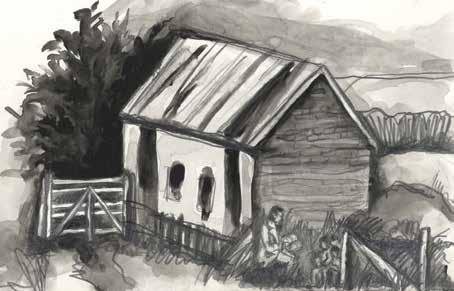
Children of all ages were educated in hedge schools, which were often located in secret places. These were informal schools with rudimentary accommodation in a barn or house in winter, or outdoors, sheltered under a hedgerow or tree in summer. The qualifications of the teachers varied widely, from well educated scholars to former hedge school pupils. In rural areas, the agricultural calendar dictated attendance at the hedge school and the teachers were often itinerant.
Teaching methods varied; as with the older bardic school tradition, repetition was often an important part of the learning process. The curriculum concentrated on reading, writing and arithmetic. Teaching was mainly in English, and in some areas, Irish. Other subjects such as classical and modern languages were sometimes taught. The schools were usually financed by parents.
In 1950, Padraic Keenan in his book, Saval in Ancient and Modern Times commented; “… Long before the days of Emancipation, ‘illegal’ schools flourished in the district, the Grant family – with a teaching tradition of over two hundred years, being prominent in this field.
As late as 1843 Hugh Grant, aged 20 years, conducted a hedge school in Croreagh. Another old master who, with thirty pupils, met “feloniously to learn” in a rude cabin built by the subscriptions of people in Carnacally, was Edward Cassidy, who was alive in 1824. His salary, subscribed by the pupils amounted to £10 annually.”
The introduction of the National Schools System in 1831 heralded the decline of hedge schools in Ireland.
Boys at Dromintee National School, south Armagh, 1923

The Education Act of 1831 provided for nondenominational education and National Schools began to be built throughout Ireland. Pictured second row, second from right, is Michael J Murphy, who left school at 14 to work as a labourer with local farmers. He developed an interest in storytelling and documented the folklore of south Armagh
Newry and Mourne Museum
Artist's impression of a hedge school Newry and Mourne Museum
Memories of St. Clare’s Convent, High Street, Newry
Kathleen Harrington
St. Clare’s Convent School was established in 1830 in High Street, Newry, following a request in 1829 by Dr. Kelly, Bishop of Dromore, to the Sisters of St. Clare to found a home with a focus on teaching the “poor females” of Newry.
My mother, all her sisters and my grandmother went to St. Clare’s and I went there as a pupil, and then taught there for thirty-nine years.
My earliest memory of the school was going into nursery class, which was the building that overlooked High Street. It was a long, low classroom, one end of it had a rocking horse and the other, a doll’s house that you could walk into. There was also a fireplace at either end, as there was no central heating.
The highlights of school life were at Feis time, the whole place was a buzz of activity with children practicing poems and choir singing. A Scottish nun, Sister Bernadette, was the fore-runner of the choral speaking, then Sister Aquinas, and after she left Ethel Fitzpatrick took over.


As a pupil, I conducted a choral speaking junior choir and brought them to the Feis. I remember running back up High Street and shouting up to the nuns’ dormitories, “Sister Aquinas we won the cup!” That’s how she knew we had won, as nuns could not leave the convent at that stage.
After leaving St. Clare’s, I went to the Sacred Heart School and it was like going from home to home, as we only had to go down a flight of steps. We did choir singing with Mons. Delafaille who was the organist in Newry Cathedral at the time, but there were less activities and a lot of work.
My teacher training was at St. Mary’s College in Belfast. We did teaching practice in Belfast in first and second year, and then back home in Newry, in St. Clare’s.
I got a teaching post in St. Clare’s Convent in 1956; a child came down to our house in Mary Street and she said “Mother Basilica said you’re to come up now, she has a class for you”.
School life went on during the Troubles, but children arrived late because of something that happened or were not sent to school at all for fear of trouble breaking out on the way home.
The best bit about teaching was seeing a child who didn’t show very much promise at the beginning, coming on at the end of Primary 7, being confident and able to speak for herself, and stand on her own two feet.
Pupils of St. Clare’s Convent Primary School pictured displaying trophies won at Newry Musical Feis in 1942. Kathleen Harrington is pictured front row, centre, wearing her Irish Dancing costume Courtesy of Kathleen Harrington
Tom King, pictured centre, Secretary of State for Northern Ireland (1985 - 1989), visiting St. Clare’s Convent Primary School in 1988 to see an exhibition on milk production connected with a Learning from Industry project Courtesy of St. Clare’s Abbey Primary School
Ballyholland Primary School
Colm McAteer
In the early part of the 19th century Ballyholland, located on the outskirts of Newry, was a densely populated townland, with an economy dependent on farming small plots of land. For those who wanted to learn, education was usually through a hedge school, with one recorded in the nearby townland of Grinan.
After the 1830s, National Schools were gradually introduced by the government. By 1902 elementary education was free and attendance at school was compulsory until the age of twelve. Local children mainly attended schools in the neighbouring townlands of the Commons and Grinan.
In the years leading up to, and during the First World War, it became apparent that a larger school was needed to accommodate the growing school population, and one-room schools such as Grinan were no longer sufficient to meet demand.
Lobbying for proper school facilities led to a site being obtained for a new school. Land was purchased from the Dowdall family, who lived near the Ballyholland cross-roads, and building work commenced in 1920.
Ballyholland School opened in April 1921, and the first pupils that joined the school were 55 boys and 52 girls. The majority of the children transferred from the Commons and Grinan schools and also the Christian Brothers and St Clare’s Convent School in Newry, while the rest were infants. Ballyholland Primary School was the first co-educational school in Newry Parish.
By the 1930s the school had three classrooms divided by a partition that could be pulled back for meetings and dances. There were two teachers at this time,
Pupils at Commons National School, 1913. The Commons school was a typical 19th school building consisting of a one room classroom and an adjoining residence for the Master. Catholic children transferred from this school to the new Ballyholland Primary School in 1921
Courtesy of William McAlpine
the Principal, Mr McGuigan, and Mrs McShane and teaching emphasis was on the three ‘Rs’, reading, writing and arithmetic.
During the Second World War, evacuees from Belfast were billeted locally and attended school in Ballyholland. In February 1944 Mr McGuigan died and was replaced with a new principal, Dan White.

Major renovations came in the mid 1960s when electric light was introduced and sanitation improved. There were now four classrooms and an office. School dinners were no longer made on site and were now delivered in large steel containers. One of the class rooms doubled as a small canteen with adjoining kitchen. Two mobile classrooms were also erected in the playground.
By the early 1980s, with an expanding school catchment area and rising pupil numbers, four more classrooms were built as well as a large dining room that doubled as an assembly hall. Meals are cooked on site and the kitchen staff has always excelled in the quality of meals provided.
The school was totally refurbished in 2006 with an additional three purpose built classrooms and a resource area added to meet demand for places in the school.
This tradition of strong support by the local community continues, and teachers and support staff provide outstanding pastoral care, teaching and sporting excellence for the pupils.
Pupils and teachers from Ballyholland Primary School after winning at Newry Musical Feis in 1956. Teachers include Mrs O’Hagan (seated centre), back row standing (left to right) Patrick Kearns, Lucy McDonald and Vincent Rennick
Courtesy of Newry Musical Feis

Mourne Grange School,
1900 – 1971
Ken Abraham
Mourne Grange Preparatory School was set up in 1900 by Allen Sausmarez Carey. Originally from Guernsey, A.S. Carey was the tutor to Francis Needham, the future 4th Earl of Kilmorey and was offered Dromindoney House on the Kilmorey estate at Mourne Park, near Kilkeel, in which to open a preparatory school. The first of its kind in Ireland, the purpose of the school was to prepare boys between eight and thirteen years of age for public school.

Although the school opened with only four pupils and three teachers, the early years saw expansion in terms of pupil and staff numbers, schools buildings and curriculum. By 1908 classrooms and dormitories had been added to the original house and the school uniform of a royal blue blazer with white edging and dark blue cap with the badge of the Carey family was being worn. Subjects taught included Mathematics, French, History, Latin and Greek. English Language and Literature were bolstered by Mrs Carey’s readings of novels to the boys on Sunday evenings, a tradition maintained by Mrs Carey until her death in 1960.
Sport also played a vital part in the school curriculum. A cricket pitch was laid out in 1903 and other games included rugby, football and athletics. In 1915, the school was divided into two houses – Greeks and Trojans – to create rivalry and competition in sport. ‘Education expeditions’ to local places of interest were also introduced and over the years there were annual excursions to destinations and notable events in Britain and Europe.
Postcard showing Mourne Grange School in the 1920s. The original Drumindoney House can be seen on the left with the 1904 extension in the centre which contained a dining hall on the ground floor and dormitories above. Further classrooms were in the building on the right Newry and Mourne Museum
By 1927 there were 92 boys, nine masters and three mistresses at Mourne Grange and these numbers remained much the same for the next ten years. In 1933, Patrick Carey, the Headmaster’s son, joined the staff. Known as ‘Mr Patrick’, his main contribution was amateur dramatics which were a major part of school life up until the 1960s, often undertaken in association with the Newpoint Players from Newry. Patrick Carey became Headmaster when his father died in 1954.
Circumstances began to change at Mourne Grange during the 1960s. A tougher economic climate, competition from other preparatory schools in Ireland, greater improvements in state education in the post-war years and a changing attitude towards sending young children away to boarding school, led to a gradual decline in pupil numbers. The school eventually closed in June 1971 and is now the home of Camphill Community Mourne Grange for adults with special needs.
Trojan XI Cricket Team at Mourne Grange School, 1952. Pupils at Mourne Grange were divided into two houses, Greeks and Trojans, for sports. Cricket was always a popular game and the school had strong teams even when pupil numbers declined in the 1960s
 Courtesy of Johnny Madden
Courtesy of Johnny Madden
History of Non-Segregated Secondary Education in Newry
Joanne Cummins
Newry High School celebrates its 50th anniversary this year. However, the origins of the school extend back much earlier to the late 19th century.
In the mid 19th century, Newry had a number of private schools. From 1858 there were calls for a state supported scheme of intermediate, non denominational education to bridge the gap between elementary and university education. As an important commercial town, Newry had need of an education system to prepare middle class pupils ‘for public service at home and abroad, for professional and mercantile life and for higher classes of industrial pursuits’.
In 1859 a deputation of gentlemen from the north of Ireland met with the Lord Lieutenant in Dublin to press the issue, with James McGeorge representing the interests of Newry.
The Intermediate Education (Ireland) Bill was finally passed in 1878. The Intermediate Board organised examinations, ensured uniform standards and paid results fees to successful school managers and prizes and exhibitions (scholarships) to successful candidates. They did not fund school buildings or pay teachers salaries. Newry Intermediate School was established in Corry Square with the Earl of Kilmorey as its patron and Henry Thompson, MP as vice-Patron. In June 1891 the school was destroyed by a fire and was transferred to Bank Parade and then to a lecture hall at Downshire Road Presbyterian Church. A new school and teacher’s residence was built on the Downshire Road in the mid 1890s.
Photograph of Newry Intermediate School in the late 1930’s. Designed by William James Watson, the school was built in the mid 1890s. In April 1921 a new wing, dedicated to the memory of past pupils who served in the First World War, was opened. A further extension was completed in 1938 and electric light installed Newry and Mourne Museum
In 1948 the school changed its name to Newry Grammar School. By 1953, with over 350 pupils, the school was hampered by a lack of adequate space, facilities and playing fields. Premises in Downshire Road and Windsor Bank were being used for classes and the staff room used as a classroom.
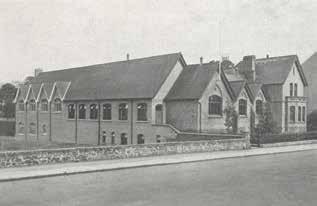
On the 1st September 1960 Newry County Intermediate School at Ashgrove was opened with 394 pupils on the register. Also known as Ashgrove Secondary Intermediate or the ‘Inter’, the school was purpose built to provide a new concept in education; education according to age, aptitude and ability, with a focus on training pupils in practical skills. The pupils even carried out grounds maintenance and grew vegetables.
In 1966, Ashgrove Secondary Intermediate and Newry Grammar School amalgamated to form Newry High School, with 860 pupils and 48 members of staff. In his report of 1966/67 Head Master Mr J.M. Clements described the new school as, “...one of the first schools
of its kind, and, we hope, due to add to the history of education in the Province. . . The High School is concerned with producing young people with open, yet critical minds, of goodwill towards their fellows of every kind of background, with a readiness to cooperate in a spirit of friendship or, at least, of understanding.” The Minister of Education for Northern Ireland, Captain W. Long, addressed the school on their first school prize day in April 1968.
The school operated between both sites for seven years, with some pupils travelling between Downshire Road and Ashgrove for lessons until new buildings were added in 1973 to accommodate the larger school at Ashgrove.
 Designed by Major G.W. Reside, Ashgrove Secondary Intermediate School opened in September 1960. The school merged with Newry Grammar to form Newry High School in 1966
Courtesy of William McAlpine
Designed by Major G.W. Reside, Ashgrove Secondary Intermediate School opened in September 1960. The school merged with Newry Grammar to form Newry High School in 1966
Courtesy of William McAlpine
Growing up in the Abbey
Christian Brother’s Grammar School
Greag Mac t’Saoir
Like many other Newry boys I spent a large part of my teenage years in the Abbey Christian Brothers Grammar School, perched above the town on Courtenay Hill. My perspective on my time there was coloured by the fact that my father Eugene McAteer, nicknamed ‘Gene Genie’ after the Bowie song, sometimes called ‘Rubiks Cube’ on account of his stocky build, was the school caretaker.
When the school opened its doors to its first pupils in 1966 my father had already worked there for three years as one of Felix O’Hare’s builders. He had become a father in 1963 and would have been glad of the steady work that such an extensive project promised. As the build progressed he attended many site meetings with the then principal Brother Newell on whom he clearly made an impression. A devout Catholic and a well known Irish dancer, he fitted the Christian Brothers’ twin preoccupations with Irish culture and conservative Catholicism. He knew the building from the girders out, so Brother Newell had good reason to recruit him as the school’s first caretaker.
My mother also worked, so from a young age I spent my Saturdays and holidays in the boiler house where my father had a workshop. I learned how to rivet lockers, glaze windows, varnish desks and reset the huge asbestos clad boilers that drove the school’s heating supply.
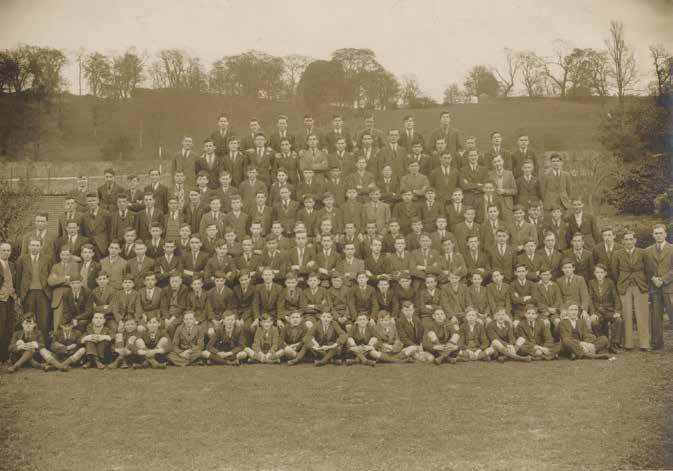
Pupils would have been familiar with the teachers and known them mostly by their nicknames.

I also knew a host of other school staff. When I started my first summer job there at the age of thirteen I worked alongside people like Paddy Campbell and later Matt McAteer, the assistant caretakers, Jimmy Smith the gardener, the lab technicians – Joe Canavan who was the lighting technician with Newpoint Players before landing a job in RTE, Anne Lappin and Bernie Finnegan who kept the science laboratories on track.
I also knew Maurice Toner and Geraldine Kane in the principal’s office, the dinner ladies, cleaners and the main office staff Pat Crawley, Mary and Tess who made sure, crucially, that everyone got paid. All these played their own parts, cogs in the complex machinery that made sure that the pupils enrolled at the school got a decent education.
A certificate for internal school examinations held at the end of Form III Newry and Mourne Museum
Pupils and teachers at the Abbey Grammar School, Newry pictured in the 1930s Newry and Mourne Museum
St. Colman’s College, Newry

 Martin Goss
Martin Goss
The Newry Telegraph of May 6th 1823, announced the opening of the Dromore Diocesan School, under the presidency of Rev John Sproule Keenan. On May 12th, the school began to operate in a “commodious house” in William Street. Its students soon numbered 40, paying an annual fee of £10 with the added attraction of cold baths “easily obtainable as the tide comes near the seminary”. However, the need for further accommodation led to the renting of a building at Violet Hill in1829. The Bishop of Dromore, Dr Michael Blake purchased the Violet Hill property on September 23rd 1834, for the nominal sum of 10 shillings and so began the long association of St Colman’s College, seminary to the Diocese of Dromore, with the Violet Hill site.
As the 1944 history of the College noted; “… Immediately upon the purchase of the building as a seminary, Dr Blake . . . set about the extension of the College. Within a year the new eastern front, in which the bishop himself was to reside, was erected and a few years later the original college chapel was added. …”
In 1875 plans were drawn up for the erection of the lower half of the present frontage and of the College Tower. Known as the “new House”, it was complete by 1879, and, viewed from the Belfast Road, remains one of the iconic images of St Colman’s College.



The next phase of College building in the 1920-1922 scheme extended the “New House” westwards adding the wing that extends from the current main entrance to the chapel steps. According to the 1944 History; “… (the) entire new set of buildings, embracing study hall, temporary Chapel, refectory, and dormitories may be said to have resulted in the complete transformation of the original College. …”
Promotional postcards for St. Colman’s College, dating from the 1920s
Courtesy of Martin Goss
1936-38 marked the commencement of the final phase of that building programme. The new Chapel of Mary, the Immaculate Mother of God, was erected at the western end of the present frontage and solemnly consecrated by Dr Mulhern on Wednesday 26th October 1938.
The transition to a day-school, the demands of the curriculum and growing numbers have necessitated the continued expansion of the College facilities and some five building schemes since 1958 have greatly enlarged St Colman’s College’s “imprint” on the Violet Hill site.
The complete re-development of the playing fields in the late 1990s improved the College’s sporting facilities. The provision of a flood-lit third-generation full size Gaelic sports pitch, the upgrading of the existing pitches, a golf practice area and an athletics track and facilities on the College site in co-operation with Sport NI and the former Newry & Mourne District Council have all been completed.
St Colman’s College at Violet Hill has expanded beyond the wildest dreams of its founders on this site almost 200 years ago and now stands magnificently placed to deliver the modern curriculum in all its varieties and to meet whatever challenges the education future may bring. Yet, the opening announcement’s mission statement of 1823 still provides St Colman’s College with its raison d’etre; “… The great end of education is to make us better men and better Christians – that howmuchsoever the mind may be enlightened, if it is not improved and directed to the great moral and religious duties, the principal object is neglected. To form and guide the tender mind in the pursuit of truth- to endeavour to impress it with a sense of religion - is the laborious yet pleasing duty of the instructor of Youth. …”
Winners of the Corn Mic Ruaidrí (MacRory Cup), 1948 – 1949

This is the annual Ulster Colleges Senior Football competition, first held in 1923. St Colman’s College have won this nineteen times, the highest number of wins for any school in Ulster
Courtesy of St. Colman’s College
Newry Municipal Technical School
Anna Marie McClelland
The Agricultural and Technical Instruction Act, 1899, came into operation on 1st April 1901, and was adopted unanimously by Newry Urban District Council in February, 1902. Under the terms of the Act, a Technical Instruction Committee was appointed, consisting of seven members of the Urban Council and nine ratepayers. In June 1902, the Newry Technical Instruction Committee, which included members such as Arthur McCann (Victoria Bakery), Henry Barcroft (Bessbrook Mill) and J.H. Russell, selected the old Town Hall as a suitable site for Newry Municipal Technical School.
Mr E. Holden was appointed Principal on the 17th October 1902, and he undertook preparation of the plans, specifications, alterations, furnishings and equipment for Newry’s first Municipal Technical School. The total cost of this work amounted to £600 15s, close to the original estimate of £600.
Technical Instruction Committees throughout Ireland were encouraged to make available such courses that would meet the needs and demands of local industries in the areas they were situated. On January 19th 1903, Newry Municipal Technical School commenced ‘Preparatory Evening Classes’. The classes were a success, and Mr Holden announced in a report in March of that year that 69 students had enrolled, with an average class attendance of 45. Trades represented included carpenters, engineers, clerks, drapers, painters, masons, plumbers, and shop assistants.
Terry Crilley (writing on the blackboard) pictured in a shorthand class in Newry Municipal Technical School c. 1900s.

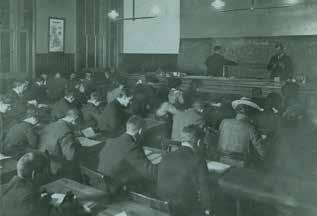
Terry Crilley was a teacher at the Abbey Christian Brothers’ Grammar School in Newry and taught evening classes at the Technical School
Courtesy of Mary Clarke
In September 1903, P.G. Hamilton Carvill, MP, formally opened Newry Municipal Technical School for the Borough of Newry and 439 students were enrolled. The school was divided into five separate departments: commercial, applied and natural sciences, engineering and building trades, art and domestic. Fireplaces were fitted into each room and the building was lighted throughout with incandescent gas lights and; “... In decorating the school, green was chosen owing to its restfulness for the students’ eyes...”
Due to demand, there was soon a need for expansion. In the 1960s the Newry Technical College occupied numerous buildings throughout Newry: Victoria Buildings on Margaret Street (now the McGrath Centre), Clanrye Building on Margaret Street, (formally the Carstands School and now demolished), the Commercial Building, Merchants Quay and another building on the Downshire Road, beside the Court
House. The Technical College became the College of Further Education in 1969 and moved to new premises on Patrick Street. It is now amalgamated with other Technical Colleges in Armagh and Down, and forms the Southern Regional College. Outside of Belfast, this is the largest Further and Higher Education College in Northern Ireland with a total of six campuses. It caters for approximately 34,000 students each year and has in excess of 900 members of staff.
Newry and Mourne Museum
Principal E. Holden (front row, centre) and staff pictured c.1912 on the steps of the Newry Municipal Technical School (now The Sean Hollywood Arts Centre)
and teacher at Newry Model School, 1951. The school opened in 1849 as a District Model National School and was the first of its type in Ulster. There were separate spaces for the “infants”, boys and girls and some students boarded
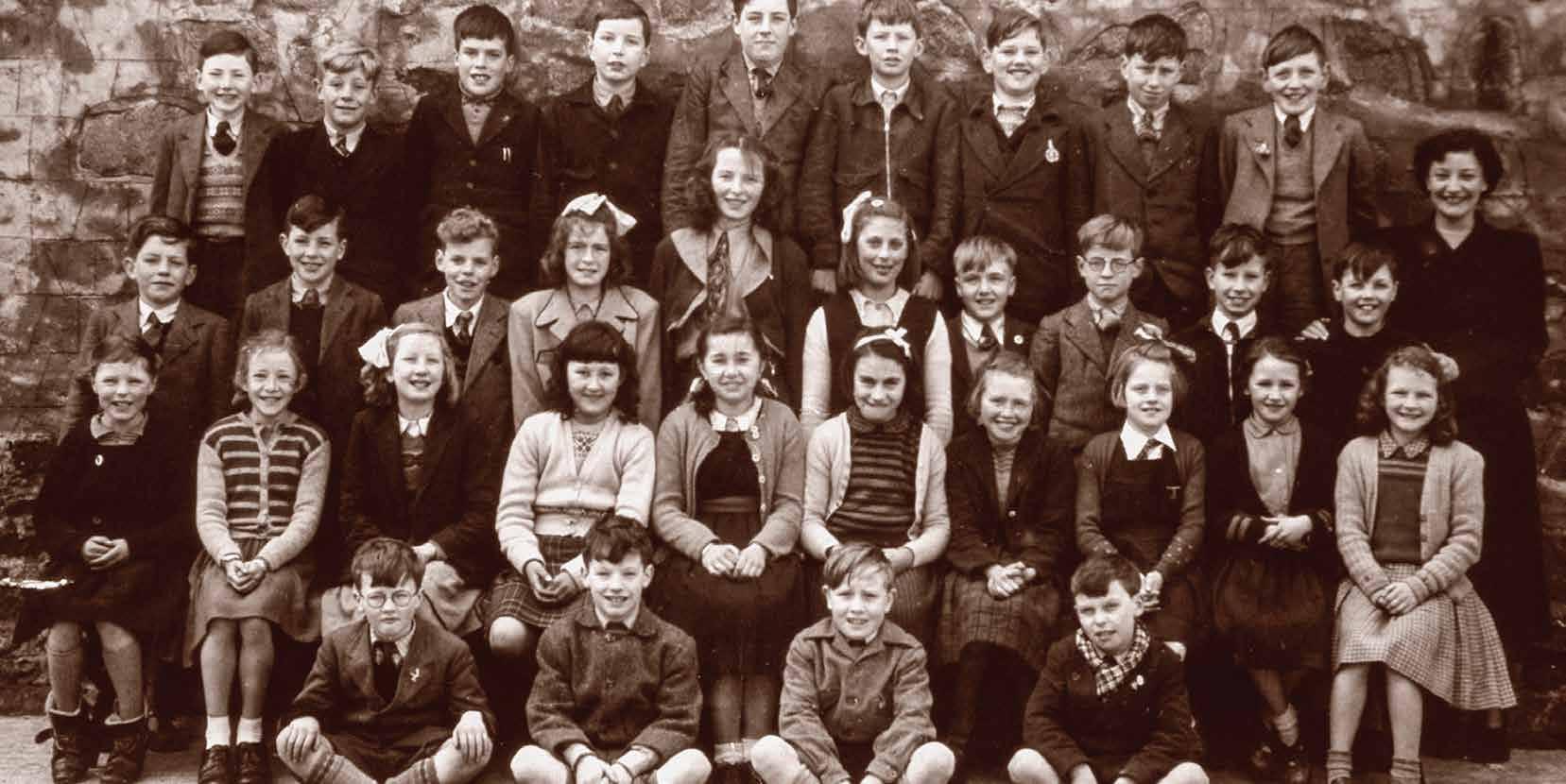 Pupils
Courtesy of William McAlpine
Pupils
Courtesy of William McAlpine

 Students and staff pictured at Kilkeel Technical Intermediate School, 1952 – 1953. The technical school was housed in part of Kilkeel Workhouse Courtesy of Catherine Hudson
Students and staff pictured at Kilkeel Technical Intermediate School, 1952 – 1953. The technical school was housed in part of Kilkeel Workhouse Courtesy of Catherine Hudson
Acknowledgements
Thanks are due to the staff, intern students and volunteers of Newry and Mourne Museum for their assistance in this exhibition and accompanying booklet:
Declan Carroll
Joanne Cummins
Barry Ferris
Caroline Hegarty
Corey McDowell
Amanda McKinstry
Francesca Owens
Sharon Paul
Anna Marie McClelland
Kelly-Marie Savage
Dympna Tumilty
We would also like to extend a special thanks to those who contributed to the exhibition through articles for the booklet, donations, loans, expertise or memories including:
Mary Clarke
Dr Mary Goss Martin Goss
Kathleen Harrington
Catherine Hudson
Johnny Madden
Greag Mac a’t Saoir
The Cummins Family
The McClean Family
Ursula Mhic An tSaoir
Colm McAteer
William McAlpine
Newry Musical Feis St. Colman’s College, Newry
Gaeláras Mhic Ardghail
Our Lady’s Grammar School St Clare’s Abbey Primary School Victoria College, Belfast
Compiled by Noreen Cunningham and Dr Ken Abraham
Every effort has been made to correctly attribute photographs used in this booklet and accompanying exhibition.
Pupils from St. Colman’s Abbey Primary School who took part in The Conceited

the Rice
concert in 1945. Back row, left to right, Frank Gray, John McMillan, John Haughey, Pedar Cowan, Frank McArdle, Noel Marron, Willy O’Hare. Front row, left to right, Eugene McKevitt, Sean Cunningham, Pat Heaney, John Kearns, Brian O’Callaghan, Bernard McGuinness Newry and Mourne Museum
Pirate at
Memorial Fund
Back cover: Drawing by Pat Hudson of the boys’ classroom at St. Colman’s (Dunavan) School, Kilkeel. Pat was a pupil at the school in the early 1930s Courtesy of Catherine Hudson




 Design: G. Watters
Design: G. Watters















 Courtesy of Johnny Madden
Courtesy of Johnny Madden

 Designed by Major G.W. Reside, Ashgrove Secondary Intermediate School opened in September 1960. The school merged with Newry Grammar to form Newry High School in 1966
Courtesy of William McAlpine
Designed by Major G.W. Reside, Ashgrove Secondary Intermediate School opened in September 1960. The school merged with Newry Grammar to form Newry High School in 1966
Courtesy of William McAlpine



 Martin Goss
Martin Goss





 Pupils
Courtesy of William McAlpine
Pupils
Courtesy of William McAlpine

 Students and staff pictured at Kilkeel Technical Intermediate School, 1952 – 1953. The technical school was housed in part of Kilkeel Workhouse Courtesy of Catherine Hudson
Students and staff pictured at Kilkeel Technical Intermediate School, 1952 – 1953. The technical school was housed in part of Kilkeel Workhouse Courtesy of Catherine Hudson





 Design: G. Watters
Design: G. Watters